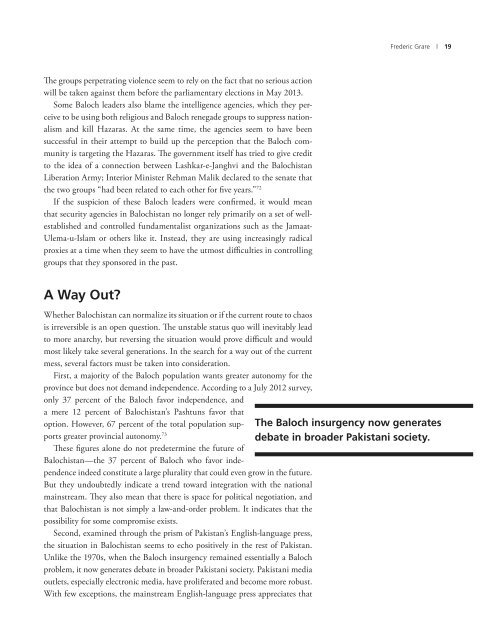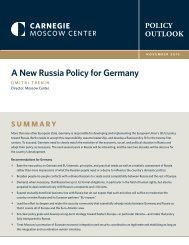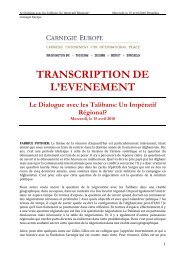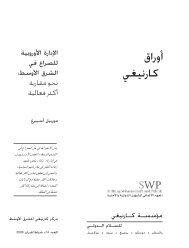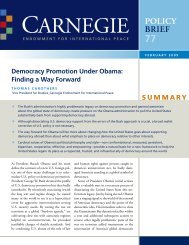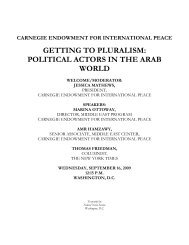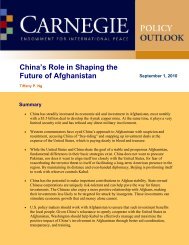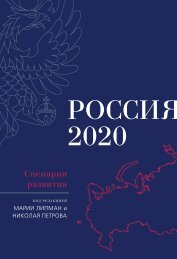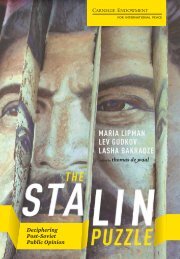BALOCHISTAN - Carnegie Endowment for International Peace
BALOCHISTAN - Carnegie Endowment for International Peace
BALOCHISTAN - Carnegie Endowment for International Peace
Create successful ePaper yourself
Turn your PDF publications into a flip-book with our unique Google optimized e-Paper software.
The groups perpetrating violence seem to rely on the fact that no serious action<br />
will be taken against them be<strong>for</strong>e the parliamentary elections in May 2013.<br />
Some Baloch leaders also blame the intelligence agencies, which they perceive<br />
to be using both religious and Baloch renegade groups to suppress nationalism<br />
and kill Hazaras. At the same time, the agencies seem to have been<br />
successful in their attempt to build up the perception that the Baloch community<br />
is targeting the Hazaras. The government itself has tried to give credit<br />
to the idea of a connection between Lashkar-e-Janghvi and the Balochistan<br />
Liberation Army; Interior Minister Rehman Malik declared to the senate that<br />
the two groups “had been related to each other <strong>for</strong> five years.” 72<br />
If the suspicion of these Baloch leaders were confirmed, it would mean<br />
that security agencies in Balochistan no longer rely primarily on a set of well-<br />
established and controlled fundamentalist organizations such as the Jamaat-<br />
Ulema-u-Islam or others like it. Instead, they are using increasingly radical<br />
proxies at a time when they seem to have the utmost difficulties in controlling<br />
groups that they sponsored in the past.<br />
A Way Out?<br />
Frederic Grare | 19<br />
Whether Balochistan can normalize its situation or if the current route to chaos<br />
is irreversible is an open question. The unstable status quo will inevitably lead<br />
to more anarchy, but reversing the situation would prove difficult and would<br />
most likely take several generations. In the search <strong>for</strong> a way out of the current<br />
mess, several factors must be taken into consideration.<br />
First, a majority of the Baloch population wants greater autonomy <strong>for</strong> the<br />
province but does not demand independence. According to a July 2012 survey,<br />
only 37 percent of the Baloch favor independence, and<br />
a mere 12 percent of Balochistan’s Pashtuns favor that<br />
option. However, 67 percent of the total population sup- The Baloch insurgency now generates<br />
ports greater provincial autonomy. debate in broader Pakistani society.<br />
73<br />
These figures alone do not predetermine the future of<br />
Balochistan—the 37 percent of Baloch who favor independence<br />
indeed constitute a large plurality that could even grow in the future.<br />
But they undoubtedly indicate a trend toward integration with the national<br />
mainstream. They also mean that there is space <strong>for</strong> political negotiation, and<br />
that Balochistan is not simply a law-and-order problem. It indicates that the<br />
possibility <strong>for</strong> some compromise exists.<br />
Second, examined through the prism of Pakistan’s English-language press,<br />
the situation in Balochistan seems to echo positively in the rest of Pakistan.<br />
Unlike the 1970s, when the Baloch insurgency remained essentially a Baloch<br />
problem, it now generates debate in broader Pakistani society. Pakistani media<br />
outlets, especially electronic media, have proliferated and become more robust.<br />
With few exceptions, the mainstream English-language press appreciates that


